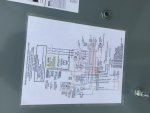200413-1303 EDT
First, we need to get rid of this "dry contact" stuff. An ordinary toggle switch unconnected to anything sitting in your hand is just a contact plain and simple. The singular use of the word "contact" in switching or logic theory is simply a device that has two states. Ideally completely open or closed.
Until a contact is wired into a circuit it is floating, connected to nothing. A real world electromechanical contact (switch) is really made up of two separate conductive contacts that can be made to touch or not When the word "contact" (singular form) is used in describing a circuit component it is really synonymous with "switch".
kwired:
My previous discussion on the possible operation of the pivot system is nonsense. Your description provides a much better basis to start from.
But first ptonsparkly's posts were:
"Tuesday 10 AM
Change of plans now that 2000' of wire is buried. nice We have a pair of #12 control wires in the raceway that were not needed originally.
Point A has control and dry contacts. Point B has a control and dry contacts. I would like to parallel the two contacts so that if either closes, it cycles both controls.
Workable or will one interfer with the other? That and distance laying directly next to 480. "
And
"Tuesday 2 PM
I was making it too hard. Typical. Point A will supply us 24VDC, run it out 2000' through a set of NO contacts controlled at Point B, then back through another NO set of contacts controlled at point A. If both closed we get a run command. Either drops or fails to close we get a stop command."
And
'Tuesday 2:14 PM
We had a full pivot and two pivot corners that were going to run separately from one well. None at the same time. Turns out well pumps way too much water and unless we added $xx,xxx VFD we were going to exceed psi rating of 30 year old buried pipe. We were set up as requested originally to run one corner or the other with radio controls. Two transmitters with one receiver at the well. We should be able to return one transmitter now."
And
"Tuesday 2:22 PM
Yes, each pivot motor will start on pressure from the remote well, closing a well relay. Each pivot has a safety circuit that will trip open the well relay circuit should something go wrong. The radio transmitter and receiver talk so it knows when the well has started and allows for time to elapse before sending a Stop. System will attempt restart at each POCO cycle of power."
And
"Thursday 5:42 PM
To make it simpler, can I use two identical timers that use terminals 5 & 6 as an initiation input connected to the same set of NO contacts? Ignore any distance at the moment. Not something I would do normally but that was essentially my original question."
And
"Friday 9:13 AN
__dan said:
It's still not clear what you want to do. I've never seen a center pivot irrigation system and cannot guess at the detailed requirements. Think a single motor running a hydraulic pump with high and low pressure limits. Simple as that at A&B locations.
From what I've gathered so far, two equipment locations, A and B. Independent starting at A or B (starting one well pump?). The well, controlled by POCO, starts A&B as water pressure comes up. And independent fault safety trip at either A or B (A and B both must be OK to run). A or B call for water, A and B both must be not tripped to run. A&B do not call for water but once they have pressure it must be maintained to keep the Well running. Radio communications allow for a 15 minute delay after start of the well and pressure acknowledgment at A&B. No confirmation or loss of pressure, stops well until POCO recycles power again.
If so, I can try to modify the earlier drawing along the same earlier premise. Is that what you want?
Not neccessary to modify your drawings. Up to you, but I think we have it figured out without having to build it from scratch. No local Radio Shack means no experimentation for me anymore.
Thank you.
I do appreciate the help all of you take the time to give. "
And
"Friday 9:30 AM
Skipping it"
And
"Friday 9:41 AM
kwired said:
This explanation makes sense, but your contacts are in series giving you an "and" function to the logic of this segment of the controls but you first said they would be parallel and was describing more of an "or" function.
You later described your application a little better - I think the "and" function is what you are needing, both pivots must be running to close the two contacts that are in series with whatever circuit is controlling the well.
My original question was with the dry contacts in parallel to two timers.
My solution is series with no timers. "
And
I will continue later working from kwired description of how the system may work.
..
cpmyact


